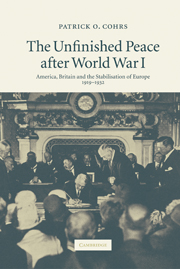Book contents
- Frontmatter
- Contents
- Acknowledgements
- List of abbreviations
- A note on the footnotes and bibliography
- Introduction
- Prologue
- 1 The wider challenges
- 2 Wilson, Lloyd George and the quest for a ‘peace to end all wars’
- 3 The ill-founded peace of 1919
- 4 The escalation of Europe's post-Versailles crisis, 1920–1923
- Part I The Anglo-American stabilisation of Europe, 1923–1924
- Part II Europe's nascent Pax Anglo-Americana, 1924–1925
- Part III The unfinished transatlantic peace order: the system of London and Locarno, 1926–1929
- Epilogue
- Conclusion
- Map: Post-World War I Europe after the peace settlement of Versailles
- Bibliography
- Index
Part II - Europe's nascent Pax Anglo-Americana, 1924–1925
Published online by Cambridge University Press: 21 July 2009
- Frontmatter
- Contents
- Acknowledgements
- List of abbreviations
- A note on the footnotes and bibliography
- Introduction
- Prologue
- 1 The wider challenges
- 2 Wilson, Lloyd George and the quest for a ‘peace to end all wars’
- 3 The ill-founded peace of 1919
- 4 The escalation of Europe's post-Versailles crisis, 1920–1923
- Part I The Anglo-American stabilisation of Europe, 1923–1924
- Part II Europe's nascent Pax Anglo-Americana, 1924–1925
- Part III The unfinished transatlantic peace order: the system of London and Locarno, 1926–1929
- Epilogue
- Conclusion
- Map: Post-World War I Europe after the peace settlement of Versailles
- Bibliography
- Index
Summary
As the aftermath of the London conference revealed, the Anglo-American settlement had opened new perspectives, yet also created a new urgency, for attempts to address what it could not resolve, at least in the short term: Europe's underlying security problem of the 1920s. British policymakers came to perceive this far more acutely than their American counterparts. From the end of the war until the climax of the Ruhr crisis, the problem had been the absence of international security per se and the lack of any effective international system to cope with endemic European instability. After London, the problem was essentially the lack of a security framework for Europe's incipient ‘economic’ stabilisation as well as Germany's resurgence and transition towards a stable republican order. Could this framework be created through the League? Would it be predicated on an Anglo-French entente after all? Or would it be founded on different, new premises?
Unmistakably, what contemporary observers simply referred to as the European security question both overshadowed and prompted the further reorientation of British policy under MacDonald in 1924 and later Chamberlain's quest for a new international equilibrium at Locarno. By contrast, the American administration and US high finance did not significantly depart from the precedent of 1924 and persevered with their ‘Progressive’ pursuit of European stability. More precisely, however, European and American policymakers faced two questions of security in the autumn of 1924.
- Type
- Chapter
- Information
- The Unfinished Peace after World War IAmerica, Britain and the Stabilisation of Europe, 1919–1932, pp. 185 - 186Publisher: Cambridge University PressPrint publication year: 2006



